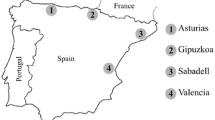Abstract
Objective: To investigate the excretion of arsenic in breast milk of lactating native Andean women living in a village in northwestern Argentina with high concentrations of arsenic in the drinking water (about 200 μg/l) and to assess the exposure of children to arsenic during the very first period of life.
Methods: The study included ten lactating women and two nursing babies. Hydride-generation atomic absorption spectrometry (HG-AAS) was used to determine the concentration of arsenic in samples of human milk, drinking water, blood, and urine.
Results: The concentrations of arsenic detected in maternal blood (total arsenic) and urine (metabolites of inorganic arsenic) were high, averaging 10 and 320 μg/l, respectively. In subjects without known exposure to arsenic the average concentrations found in blood and urine are 1–2 and about 10 μg/l, respectively. The metabolites of inorganic arsenic constituted more than 80% of the total arsenic in the urine, which shows that inorganic arsenic was the main form of arsenic ingested. The average concentration of arsenic detected in human milk was 2.3 μg/kg fresh weight (range 0.83–7.6 μg/kg). Although data on background levels of arsenic in human breast milk are scarce, the present concentrations seem to be slightly elevated. However, considering the high levels of arsenic exposure in the mothers, the total arsenic concentrations measured in human milk were low. In concordance with the low concentrations of arsenic found in the milk, the concentrations of arsenic metabolites measured in the urine of two of the nursing babies were low: 17 and 47 μg/l, respectively.
Conclusions: The low concentrations of arsenic detected in the breast milk and urine of the two nursing babies in relation to the high level of maternal exposure to arsenic indicate that inorganic arsenic is not excreted in breast milk to any significant extent. This is a very important reason for long breast-feeding periods.
Similar content being viewed by others
Author information
Authors and Affiliations
Additional information
Received: 27 February 1997 / Accepted: 6 June 1997
Rights and permissions
About this article
Cite this article
Concha, G., Vogler, G., Nermell, B. et al. Low-level arsenic excretion in breast milk of native Andean women exposed to high levels of arsenic in the drinking water. Int Arch Occup Environ Health 71, 42–46 (1998). https://doi.org/10.1007/s004200050248
Issue Date:
DOI: https://doi.org/10.1007/s004200050248




